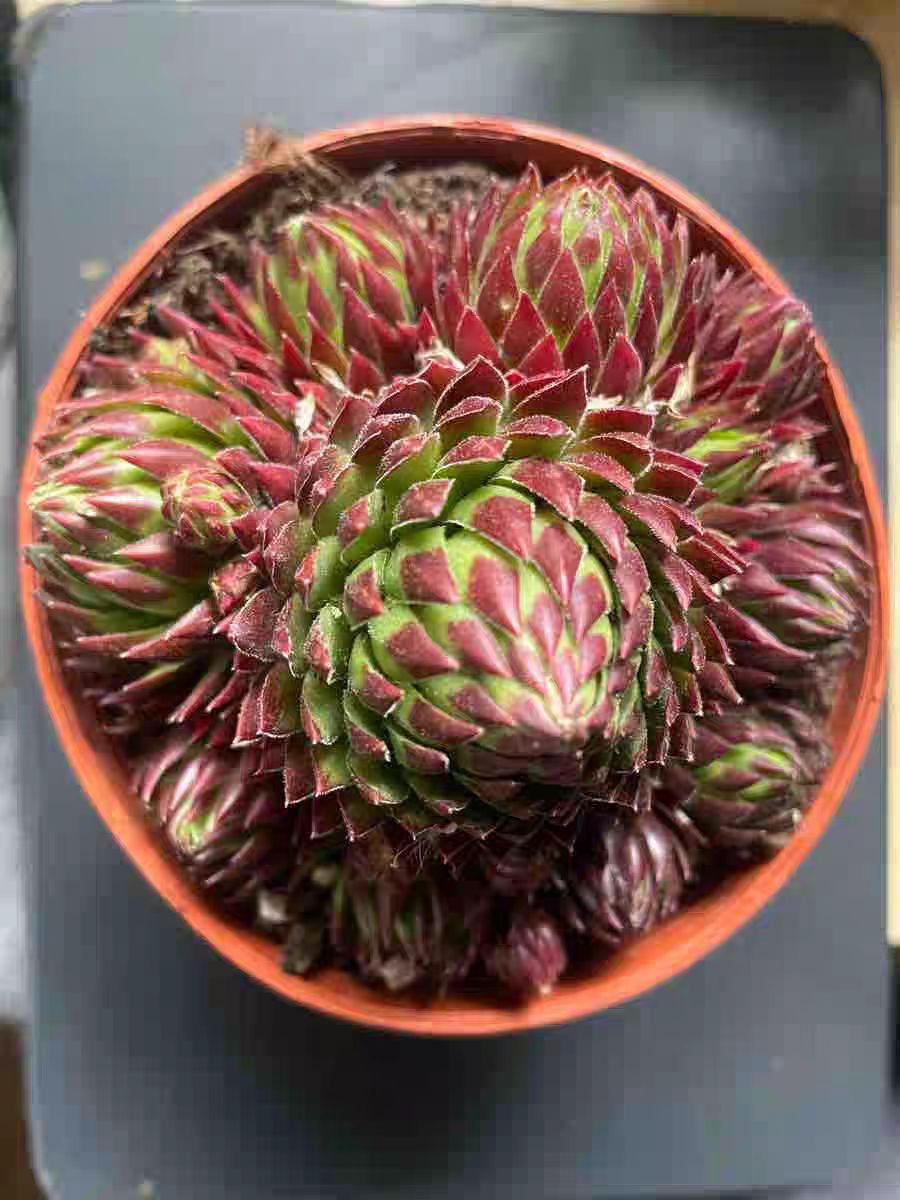Many friends who grow succulents wonder whether Sempervivum succulents go dormant in summer. In fact, Sempervivum does enter a dormant state in summer. This type of succulent is a typical "winter grower," meaning it thrives better in winter, with the most suitable temperature range being 15-25°C. When the summer temperature continuously exceeds 30°C, it activates a "power-saving mode," automatically stopping growth to protect itself.
During this period, you can observe that the inner leaves of the plant gather toward the center, the outer old leaves gradually wither and are consumed, and the leaf color changes from a beautiful jelly-like hue to dark green or grayish green. These are all obvious signs of its dormancy. This phenomenon is related to its native environment - it originates from the alpine rock regions of Europe, where summer is dry and rainless. Dormancy helps it reduce water evaporation and nutrient consumption, so we should adapt our maintenance methods to this habit.
Is it difficult to care for Sempervivum in summer? To be honest, it is indeed more challenging compared to spring and autumn, but there is no need to worry too much. As long as you master a few key techniques, you can still help it survive the summer safely. The biggest challenge in summer is the contradiction between high temperature and high humidity and its weak resistance during dormancy: on one hand, when the temperature exceeds 35°C, water evaporates quickly from the leaves, but the root absorption capacity deteriorates at this time, making the plant prone to dehydration and wilting, and the leaves can also get sunburned; on the other hand, if there is too much rain or too frequent watering, water will accumulate in the potting soil, and the dormant roots will have poor respiration, making them particularly prone to root rot, which manifests as leaf waterlogging and blackening at the base; in addition, in high-temperature and high-humidity environments, scale insects, aphids, and various fungal diseases tend to multiply. The resistance of dormant succulents is weak, and once affected by pests and diseases, they spread much faster than usual.
Next, let's talk about specific maintenance methods. First, the environment is very important - you need to find a cool and ventilated place for it. You can set up a shade net with a shading rate of 50%-70%, and move it to a place with scattered light, such as the inner side of the balcony or the lower layer of the windowsill flower rack. Make sure it is not exposed to the sun during the three hottest hours at noon. If the temperature is too high, it is best to use air conditioning or a fan to cool it down, and try to keep the temperature below 32°C. Ventilation should not be ignored - if it is grown outdoors, place it on an open balcony or under a tree shade; if it is grown indoors, open the window for ventilation at least 4 hours a day. If the air feels too stuffy, you can turn on a small fan to keep the air flowing and reduce humidity.
Watering requires special care. Remember the principle of "water thoroughly when the soil is dry," but reduce the frequency of watering by half to 70% compared to spring and autumn. How to determine when to water? Check if the inner leaves are slightly wilted, or insert a toothpick into the soil - if the bottom 1cm is dry when pulled out, it is time to water. Water in the cool morning or evening, never at noon. Use a narrow-spouted watering can to slowly water along the edge of the pot, and do not let water accumulate in the center of the leaves, as this can cause heart rot. If it is grown outdoors, dry the water in the leaf center in time after rain, and it is best to provide rain shelter in advance during continuous rain to prevent the potting soil from staying wet.
The choice of soil and pot also has a great impact. The soil should contain 60%-70% granular soil to ensure good air permeability and drainage. For example, you can mix 3 parts peat soil, 3 parts volcanic stone, 2 parts macroporous stone, and 2 parts coconut coir. Remember to replace the soil every spring to prevent the old soil from compacting and causing water accumulation in summer. It is best to use breathable pots such as red clay pots or coarse pottery pots, with a size 1-2cm larger than the plant's crown width. The bottom of the pot should have more than 3 drainage holes. Avoid using porcelain pots or plastic pots, as they can easily cause root suffocation in summer.
Pest and disease prevention should be done in advance. At the beginning of summer, conduct a comprehensive inspection, clean up dead leaves and weeds, and spray with carbendazim and abamectin once to sterilize and kill insects. Usually, pay more attention to the back of the leaves and the leaf center. If a small number of scale insects are found, wipe them off with a cotton swab dipped in alcohol. In severe cases, you need to take the plant out of the pot, wash the roots, soak them in Huahushen (a plant protection agent) for 30 minutes, and then replant with new soil. If you see black rot or waterlogging in the leaves, quickly cut off the damaged parts, apply plant ash or carbendazim, and try leaf cutting or stem cutting after drying.
In summary, the key to summer maintenance of Sempervivum is to follow its dormancy pattern, create a cool, ventilated, and low-water environment, and prevent pests and diseases in advance. As long as we observe more, take care carefully, and master these techniques, we can keep Sempervivum healthy even in summer, and wait for it to grow beautifully again in autumn and winter.
Do Sempervivum succulents go dormant in summer?

Share with
Tagged in :




Leave a Reply